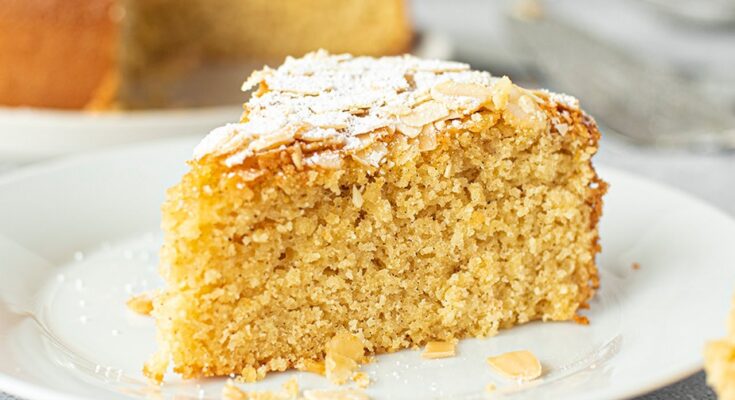Almond Cake Recipe: Almond cake is one of those desserts that sneakily captures your heart. It’s rich, it’s nutty, and it smells absolutely divine when it’s baking. What sets it apart from a traditional sponge or butter cake is its core ingredient: almond flour. This gives the cake a unique, slightly crumbly yet moist texture and a warm, nutty flavor that you don’t get with regular flour-based cakes. It’s a go-to treat when you’re craving something both simple and a little bit elegant.
And the best part? It’s naturally gluten-free if you skip the all-purpose flour altogether. So, if you’ve got friends or family members with dietary restrictions, almond cake is a win-win. Plus, it’s super versatile—you can serve it as a plain tea cake, dress it up with whipped cream and berries, or go all-in with a sweet glaze.
A Brief History of Almond-Based Desserts
Almonds have been part of the dessert scene for centuries, especially in Mediterranean and Middle Eastern cuisines. From the Spanish tarta de Santiago to Italian amaretti and marzipan, almonds have been beloved for their taste and versatility. The almond cake as we know it today probably evolved from these traditional recipes, eventually making its way into European kitchens and beyond.
What’s beautiful about the almond cake is how universal it has become. While every region puts its own spin on it, the soul of the cake remains the same—simple ingredients, rich taste, and that unmistakable almond aroma that fills your kitchen.
Ingredients You’ll Need
Core Ingredients for a Classic Almond Cake
Before you start baking, let’s gather the essentials. Here’s what you’ll typically need:
- Almond Flour: The star of the show. Finely ground, blanched almond flour works best for a smooth texture.
- Eggs: Usually around 4 to 5, depending on the recipe. They provide structure and moisture.
- Sugar: Regular granulated sugar, but you can also use cane sugar or coconut sugar.
- Butter: Unsalted butter gives the cake richness. Make sure it’s softened.
- Vanilla Extract: Just a splash enhances the nutty flavor.
- Salt: A pinch helps balance the sweetness.
- Baking Powder: Optional, but it gives a bit of lift.
That’s it! This cake doesn’t need any fancy ingredients—just quality basics that come together beautifully.
Optional Add-ins to Elevate the Flavor
Want to get a little creative? Here are some extras you can mix in or top your cake with:
- Orange or Lemon Zest: For a fresh citrusy note.
- Almond Extract: If you want to double down on almond flavor.
- Slivered Almonds: Sprinkle on top for crunch.
- Powdered Sugar: A light dusting before serving looks gorgeous.
- Fresh Berries: Pair perfectly with the nutty base.
- Honey or Maple Syrup: For a more natural sweetener option.
These additions aren’t necessary, but they can take your almond cake from “yum” to “WOW.”
Tools and Equipment Required
Kitchen Essentials
You don’t need a commercial kitchen to make a killer almond cake, but having the right tools helps a ton. Here’s what you’ll want on hand:
- Mixing Bowls: At least two—one for dry, one for wet ingredients.
- Whisk and Spatula: To mix and fold the batter gently.
- Hand Mixer or Stand Mixer: Optional but useful for whipping eggs and butter.
- Cake Pan: An 8-inch or 9-inch round pan is ideal.
- Parchment Paper: For lining the pan and easy unmolding.
- Measuring Cups and Spoons: Precision is key!
Optional but Helpful Tools
These aren’t must-haves, but they make life easier:
- Springform Pan: Makes it easier to remove the cake without flipping.
- Cooling Rack: Helps your cake cool evenly.
- Zester or Microplane: If you’re adding citrus zest.
Having these tools prepped before you start baking makes the process super smooth.
How to Make Almond Cake – Step-by-Step Instructions
Step 1: Preheat and Prep
First things first—preheat your oven to 350°F (175°C). While that’s heating up, grease your cake pan with butter or line it with parchment paper. You don’t want your cake sticking after all that effort.
This is also the time to measure out all your ingredients. Trust me, having everything in place (called “mise en place” in the culinary world) will make your baking session stress-free and way more fun.
Step 2: Mixing Dry and Wet Ingredients
In one bowl, whisk together your almond flour, salt, and baking powder (if using). In another, beat your eggs and sugar until they’re pale and slightly thickened—this takes about 2-3 minutes with a mixer. Add the softened butter and vanilla extract to the wet mix.
Once both mixtures are ready, slowly add the dry ingredients into the wet mix. Fold it in gently using a spatula. Overmixing can ruin the texture, so be gentle and just mix until combined.
Step 3: Folding in the Almond Flour
Now comes the moment where the magic happens—folding in the almond flour. This step gives your batter that signature texture and nutty richness that defines an almond cake. The key here is not to rush. Almond flour is more delicate than regular flour, and it can get a little dense if you’re too aggressive.
Add the almond flour in batches—about a third at a time—folding it gently with a spatula after each addition. Don’t use a mixer here; hand folding helps maintain the airiness you whipped into the eggs earlier. You’ll notice the batter start to thicken and take on a creamy, pale yellow hue with a lovely grainy finish from the almonds.
If you’re adding in extras like lemon zest or almond extract, this is the time to gently fold those in as well. The goal is a smooth, well-blended batter that smells like heaven already—even before it hits the oven.
Step 4: Baking the Cake
Transfer your batter into the prepared cake pan, using a spatula to even it out so it bakes uniformly. Give the pan a gentle tap on the counter to eliminate any large air bubbles trapped inside the batter. Then, slide it into the preheated oven.
Bake for 30 to 40 minutes, depending on your oven and pan size. Keep a close eye on it starting at the 30-minute mark. You’ll know it’s done when the top is golden brown, the edges pull slightly away from the pan, and a toothpick inserted into the center comes out clean or with just a few moist crumbs.
Resist the urge to open the oven door too often—doing so drops the temperature and can lead to an uneven bake. Trust the process, and let the sweet almond aroma be your timer.
Step 5: Cooling and Unmolding
Once the cake is out of the oven, let it rest in the pan for about 10–15 minutes. This waiting period allows the cake to set, making it less likely to break when you remove it. If you used a springform pan, gently release the sides. Otherwise, run a knife around the edge and carefully invert it onto a wire rack.
Let the cake cool completely before adding any toppings or cutting into it. A warm almond cake might smell irresistible, but slicing too early can lead to crumbling. Once it’s cool, the structure firms up, giving you those perfect, tender slices with just the right amount of crumb.
Tips for the Perfect Almond Cake
Moisture Retention Tricks
Almond cakes are naturally moist thanks to the fat content in almonds, but a few tricks can help you lock in that heavenly texture even more:
- Don’t Overbake: The top should be golden but not dark. Overbaking dries out the cake, making it crumbly.
- Add a Syrup Soak: A light brush of simple syrup or orange juice right after baking keeps it super moist.
- Use Room Temperature Ingredients: They blend better and trap air more effectively, making the cake light and fluffy.
Want an ultra-moist cake? Swap out some of the butter for Greek yogurt or sour cream. Just a couple tablespoons will do the trick without altering the flavor much.
Getting the Right Texture
The beauty of an almond cake lies in its texture—moist, slightly dense, and a little crumbly. But how do you nail that every time?
- Use Fine Almond Flour: Not almond meal, which is coarser and includes skins.
- Avoid Overmixing: Once the almond flour is in, gently fold. The more you stir, the tougher your cake will be.
- Don’t Skip the Eggs: They act as both a binder and leavening agent. Fresh eggs whipped well can make or break your cake’s fluff factor.
Finally, let the cake cool fully before slicing. Almond cakes can fall apart if you rush this step, so exercise some patience—it’s totally worth it.
Serving Suggestions
Simple Garnishes and Toppings
You don’t need to go over the top to serve almond cake in style. A minimalist approach often works best:
- Dust with Powdered Sugar: Classic and elegant.
- Top with Slivered Almonds: Toast them for added crunch and aroma.
- Add Fresh Berries: Strawberries, raspberries, or blueberries give it a pop of color and tartness.
- Drizzle with Glaze: Mix powdered sugar with a splash of milk or lemon juice for a simple icing.
Want to be extra? Try a dollop of mascarpone cheese or a spoonful of whipped cream on the side.
Pairing Ideas for Beverages and Sides
Almond cake pairs beautifully with a range of drinks and side treats. Here are a few favorites:
- Coffee or Espresso: The bitterness of coffee balances the sweetness of the cake.
- Herbal Tea: Chamomile, mint, or lavender tea complement its nutty profile.
- Vanilla Ice Cream: For an indulgent dessert combo.
- Fruit Compote: A warm berry or peach compote spooned over the cake adds tang and moisture.
This is a cake that can go casual or classy. Whether it’s a weekday coffee break or a weekend dinner party, it always finds a way to fit in and shine.
Variations of Almond Cake
Gluten-Free Almond Cake
If you’re looking for a gluten-free dessert that doesn’t compromise on taste, almond cake is your best friend. In fact, many traditional almond cake recipes are already gluten-free. That’s because almond flour acts as the base, eliminating the need for any wheat-based flours. But if your recipe calls for a bit of all-purpose flour, you can easily swap it out.
Here’s how to make a fully gluten-free version:
- Use 100% almond flour – no wheat flour required.
- Ensure that your baking powder is labeled gluten-free.
- Use cornstarch or arrowroot powder to help with structure if needed.
- Add an extra egg if the batter feels too thin. This helps bind everything together.
The result? A cake that’s rich, moist, and slightly dense—in the best way possible. You can’t even tell it’s gluten-free. This makes it ideal for sharing with friends and family who are sensitive to gluten, all without sacrificing any of the yum factor.
Almond Cake with Fruit Infusion
Want to add a little twist to your traditional almond cake? Let’s talk fruit infusion. Adding fruit to your almond cake brings a whole new dimension of flavor and moisture. And there are so many ways to do it!
Some favorite fruit combinations include:
- Blueberry Almond Cake – Fold fresh or frozen blueberries into the batter.
- Orange Almond Cake – Add orange zest and juice for a bright, citrusy kick.
- Cherry Almond Cake – A summer favorite with tart cherries baked right in.
- Apple Cinnamon Almond Cake – Fall vibes in every bite.
When adding fruit, make sure to pat it dry before mixing it into the batter. Wet fruit can weigh down the cake and alter the bake. Also, dusting fruit with a bit of almond flour helps it stay suspended throughout the cake instead of sinking to the bottom.
These variations are simple to pull off and are guaranteed to impress.
Storage and Shelf Life
Keeping It Fresh
Let’s be real—this cake is so delicious, it probably won’t last long. But just in case you’ve got leftovers (or you made it ahead of time), here’s how to store it properly:
- At Room Temperature: Store the cake in an airtight container for up to 2 days. Keep it in a cool, dry place away from direct sunlight.
- In the Refrigerator: Wrap it tightly in plastic wrap or store in a sealed container for up to 5–6 days. Let it come to room temp before serving for the best texture.
- Add a Paper Towel: To absorb excess moisture and prevent sogginess, place a paper towel inside the container with the cake.
Freezing Tips
Yes, you can freeze almond cake—and it freezes beautifully. Here’s how:
- Let the cake cool completely first.
- Wrap it tightly in plastic wrap, then again in aluminum foil.
- Store it in a freezer-safe bag or container.
- It’ll keep well for up to 2 months.
To serve, thaw it in the fridge overnight or let it sit at room temperature for a few hours. You can warm individual slices in the microwave for about 15–20 seconds if you want that fresh-from-the-oven feel.
Common Mistakes to Avoid
Overbaking or Underbaking
This is the number one issue people face when baking almond cake. Almond flour behaves differently than regular flour—it browns faster and can dry out if overbaked.
Here’s how to avoid it:
- Always start checking the cake around the 30-minute mark.
- Use a toothpick test: it should come out with moist crumbs, not completely clean.
- Don’t rely solely on the timer—your nose knows! When the kitchen smells heavenly and the top is golden, it’s probably ready.
Underbaking is less common but just as problematic. A wet center means the structure didn’t fully set, which can make slicing messy and the texture gummy.
Ingredient Substitution Issues
Swapping ingredients is fun and creative—until it backfires. Almond cake is a delicate balance, and certain subs can throw it off.
Avoid these common mistakes:
- Using almond meal instead of almond flour: Almond meal includes skins and has a coarser texture, which changes the crumb.
- Replacing eggs with watery alternatives: Eggs are key for structure. If going egg-free, use thicker substitutes like yogurt or flax eggs—but be prepared for a denser result.
- Cutting back too much on sugar or butter: These not only affect taste but also moisture and texture.
The rule of thumb? Experiment slowly and one change at a time.
FAQs about Almond Cake Recipe
1. Can I use almond flour instead of all-purpose flour?
Absolutely! Almond flour gives the cake a nuttier flavor and makes it gluten-free. Just keep in mind, it may result in a denser texture—so adjust your liquids if needed.
2. How do I store almond cake to keep it fresh?
Store it in an airtight container at room temperature for up to 3 days, or refrigerate it for up to a week. You can also freeze slices for up to 3 months.
3. Can I make almond cake without eggs?
Yes, you can substitute eggs with unsweetened applesauce, mashed bananas, or yogurt. Just know it might slightly change the texture and richness.
4. Is almond cake healthy?
Healthier than most! Almonds are packed with healthy fats, protein, and fiber. Swap out refined sugar for honey or maple syrup to make it even more wholesome.
5. What’s the best frosting for almond cake?
Buttercream, cream cheese frosting, or a simple dusting of powdered sugar all pair beautifully. If you’re feeling fancy, try an orange glaze or raspberry compote on top!
6. Can I add fruit or chocolate to almond cake?
Oh, absolutely. Fresh berries, sliced apples, or dark chocolate chips take it to the next level. Just fold them in gently before baking.
7. Why did my almond cake sink in the middle?
Likely culprits: overmixing, opening the oven too soon, or underbaking. Make sure your oven is preheated and don’t peek too early—resist the urge!
Conclusion
Almond cake is the kind of dessert that hits all the right notes—it’s rich yet light, sweet but not overpowering, and rustic yet elegant. Whether you’re making it for a family brunch, a holiday get-together, or just because you’re craving something cozy, this cake delivers every single time.
With just a few simple ingredients and a little bit of love, you can whip up a cake that tastes like it came from a fancy bakery. Plus, it’s super customizable, gluten-free friendly, and stores like a dream.
So next time you’re in the mood to bake, skip the box mix and go for the almond cake. Trust me—once you taste it, you’ll keep coming back for more.



